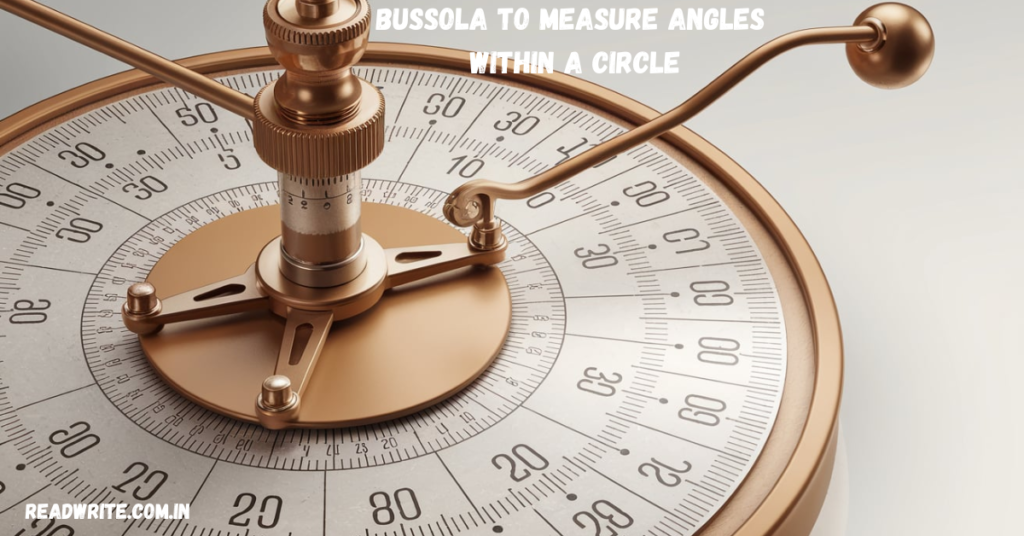Measuring angles is a fundamental aspect of geometry, engineering, navigation, and various scientific disciplines. One of the tools traditionally used for this purpose is the bussola, an instrument that has its roots in historical navigation but has found applications in modern geometric and surveying practices. This blog post delves into the usage of a bussola to measure angles within a circle, exploring its history, functionality, applications, and how to achieve precise measurements.
What is a Bussola?
The term “bussola” originates from the Italian word for “compass.” Historically, a bussola was primarily a navigational tool used to determine directions. Over time, it evolved into an instrument capable of measuring angles within circles, especially for surveying and geometrical applications.
In essence, a bussola consists of:
- A Circular Base: Often marked with degrees or radians to facilitate angle measurement.
- A Rotating Needle or Dial: Used to indicate direction or the measured angle.
- A Center Pivot Point: Acts as the axis for rotation, crucial for accuracy.
The Importance of Measuring Angles in a Circle
Understanding angles within a circle is critical for many reasons:
- Geometry and Mathematics: Circles are central to trigonometry, calculus, and various geometrical problems.
- Navigation: Determining direction and plotting courses relies on accurate angle measurement.
- Engineering and Design: Circular components in machinery and architecture demand precise angular calculations.
- Astronomy and Physics: Studying celestial movements or rotational dynamics often involves angles within circles.
How a Bussola Measures Angles Within a Circle
Using a bussola to measure angles involves a systematic process:
1. Setting Up the Bussola
- Place the bussola on a stable, flat surface to prevent any deviations.
- Ensure the circular base is aligned properly, often with a reference point or cardinal direction.
2. Identifying Key Points
- Mark the center of the circle where the pivot point of the bussola will rest.
- Identify the points on the circumference of the circle that represent the angles to be measured.
3. Measuring the Angle
- Align the bussola’s needle or indicator with the first point.
- Rotate the dial or the entire instrument to align with the second point.
- Read the degree or radian measurement displayed on the bussola’s scale.
4. Recording the Measurement
- Note the measured angle, ensuring no parallax error.
- If required, repeat the process for increased accuracy.
Applications of Bussola in Measuring Angles
The bussola’s versatility makes it an indispensable tool in various fields:
1. Surveying and Cartography
Surveyors often use a bussola to measure angles for creating accurate land maps. The instrument is ideal for calculating bearings and triangulating positions.
2. Astronomy
Astronomers use tools similar to a bussola to measure the angular position of celestial bodies within their circular paths.
3. Education
A bussola serves as an excellent educational tool for teaching geometry and trigonometry, allowing students to visualize and measure angles in real-world contexts.
4. Engineering and Construction
Engineers rely on accurate angular measurements to design circular components, such as gears, wheels, and rotary systems.
Advantages of Using a Bussola
- Accuracy: A bussola offers precise angular measurements, essential for technical applications.
- Portability: Compact and lightweight, it can be easily transported to different locations.
- Ease of Use: Its straightforward design makes it accessible even to beginners.
- Versatility: Applicable across diverse disciplines, from education to professional engineering.
Tips for Accurate Angle Measurement with a Bussola
Achieving accurate measurements requires attention to detail and careful handling:
- Calibrate Regularly: Ensure the bussola is properly calibrated to avoid measurement errors.
- Avoid Magnetic Interference: As many bussolas are magnetic, keep them away from electronic devices or metal objects.
- Check Stability: Ensure the bussola is placed on a stable, level surface.
- Use Reference Lines: Mark clear reference lines on the circle to enhance precision.
- Practice Patience: Rotate the dial or needle slowly to ensure accurate alignment.
Common Mistakes to Avoid
- Neglecting Calibration: Using an uncalibrated bussola can lead to significant errors.
- Rushing the Process: Hasty measurements increase the likelihood of inaccuracies.
- Ignoring External Factors: Environmental factors, such as wind or uneven surfaces, can affect results.
- Misinterpreting the Scale: Always double-check the scale and units (degrees vs. radians).
Modern Alternatives and Enhancements
While the traditional bussola remains relevant, modern technology offers alternatives and enhancements:
- Digital Bussolas: Equipped with electronic displays and sensors, these provide precise digital readouts of angles.
- Smartphone Apps: Many mobile apps mimic the functionality of a bussola, using gyroscopes and accelerometers for measurements.
- Theodolites: Advanced surveying instruments with higher precision and additional features, such as distance measurement.
Despite these advancements, the simplicity and reliability of a traditional bussola often make it the preferred choice for many users.
Conclusion
The bussola to measure angles within a circle is more than just a navigational tool; it’s a versatile instrument for measuring angles within a circle. Whether in surveying, education, or engineering, the bussola’s practicality and precision make it indispensable. By understanding its functionality and following best practices, you can harness its full potential for accurate angular measurements.
In a world increasingly dominated by digital solutions, the bussola stands as a testament to the enduring value of traditional tools. Its ease of use, portability, and timeless design ensure that it remains relevant across various applications. So, whether you’re a student exploring geometry or a professional in need of precise measurements, the bussola offers a reliable and effective solution.
Start using a bussola today, and experience the satisfaction of mastering angles within a circle with unparalleled accuracy!

